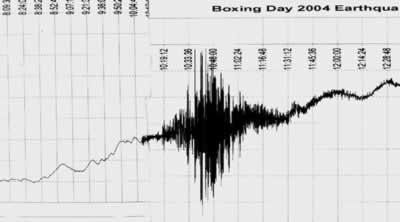Seismic and Micro-Seismic Monitoring
The Metacoustics team has a number of "high precision tilt meters" which allow the monitoring of tilt from earth tides, micro-seismic activity in and around the monitored structure and seismic data on a world wide scale is recorded and analysed. Over the 40 years that we have been working on this project, monitoring equipment, instrumentation, data recording, data analysis and data interpretation techniques have been developed in the Micro-seismic (MS) and Acoustic Emission (AE) technologies. The use of the high-precision tilt meter has added a valuable data source to large-structure monitoring such as dams, mines, powerplants and bridges. Only one tilt meter has been in use, as the major requirement was very localised around the structures being monitored. At least three tilt meters are required for any source location. However, this one tilt meter does detect data from earthquakes all around the world. The tilt meter record below was recorded at our Sydney, Australia laboratory on 26 December th 2004, and is a record of the earth quake in the Sumatra area on that day.

This graph was produced by joining two pages of data, each with about 50,000 data points, and shows the earth tide, with the earthquake superimposed on it, and a number of variations at the start, thought to be associated with plate movement in the Sumatra area. The activity shown in this section of the graph, started about 2 hours before the actual earthquake, and is not necessarily the start of our records of activity from the Sumatra area. The low peak amplitude data at about 10.10 am on the record is associated with the pre-quake stress in the area of the ultimate plate movement. The major signal is associated with plate material movement, in hindsight, probably associated with the downward movement of the "southern" plate and subsequent movement under the "upper" plate. The associated plate movement and rock displacement continued for some hours.
The high quality of this data should allow pulse frequency analysis, and from other work on small scale samples, there are indications that pulse velocity and frequency component is related to the localised stress of the material being monitored. Thus with a carefully placed grid of these instruments, it should be possible to monitor the Earth/Indian Ocean area and provide an early warning of earthquakes. However, there is a lot of data interpretation required over many earthquakes before that is a reality, but one has to start somewhere.
Metacoustics has expertise in acoustic emission which is basically very high frequency micro-seismic activity. We have developed successful technology for pressure equipment, bridges, dams and mines and most materials, including geologic formations. The current "state of the art" shows that analysis of the Acoustic Emission/Micro-seismic data can be used to indicate/predict material failure. This is very successful in metal structures, and our research to date indicates that the same basic analysis, with modifications to cope with the nature of geologic materials, is proving to be successful on rock also. This analysis indicates changes in "local stress" in the zones monitored, and also "finds" places where failure/activity/earthquakes can be expected. Naturally, the more intense the monitoring array, the more successful and precise the results.